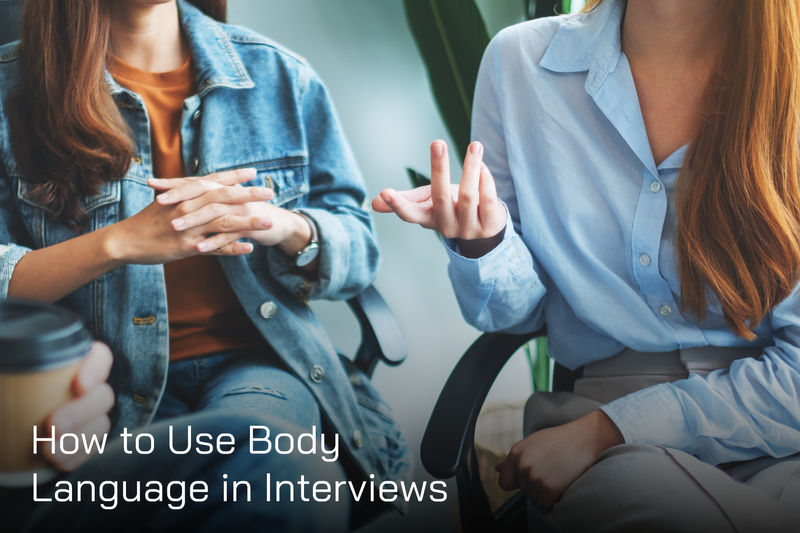
Much more than having a well-curated resume and cover letter that’ll help you land an interview, having positive body language will impress your interviewer even if your responses are flawed. That said, your appearance, tone of voice, body posture, hand gestures, and facial expressions matter a lot when going in for your interview, as they are another essential basis for developing a perspective about you and judging your performance. This article will expound more on how to adopt positive language before and during your interview.
What is Positive Body Language?
Body language is a non-verbal communication type through body movement and gestures that either communicate a positive or negative level of interest, enthusiasm, and positive reactions towards someone, something, or a situation. Positive body language often includes appropriate eye contact, active engagement/listening, and targeted gestures that accentuate the message you’re trying to convey in a confident and influential way.
Your body language during a job interview often projects your emotions onto the interviewer. However, with positive body language, your interviewer gets to focus on what you’re saying rather than how you behave. Doing this will also help your interview process what you’re communicating efficiently.
What is the Importance of Having Positive Body Language?
Research shows that at least 70% of communication is nonverbal, meaning having positive body language often signals how we genuinely feel. So, having or using positive language during your interviews makes you look more likable, competent, persuasive, emotionally intelligent, calm, and confident even in situations where emotions run high.
Body language is usually subconscious, but with practice, you can learn to control and project positive body language with confidence during your interviews. Positive body language also helps to build interpersonal workplace relationships because you’ll seem more approachable and non-defensive to your co-worker. It also helps to break the barrier of unfamiliarity.
Frequently Asked Questions
What is some do’s positive language during an interview?
Body language is one way you can indicate your comfort, confidence, and interest in the company and the role, so start by walking confidently into your interview room. Your positive body language should also include a firm handshake that makes an interviewer feel your enthusiasm and confidence.
Recruiters often employ people who look more relaxed and personable, and as simple as a smile, you’ll come off with that look. Don’t forget to sit straight while maintaining eye contact and leaning toward the interviewers to show them that you’re interested in the conversation. It’s also okay to make hand gestures when trying to make a point, but don’t be too extra.
How can I avoid negative body language during interviews?
Negative body language starts with overconfidence, which is not always an excellent way to begin an interview. So be polite, and humble and use your curiosity judiciously. Avoid staring, slouching, crossing your arms, fidgeting, or being overly friendly. Suppose you have a habit of touching your face or adjusting your hair repeatedly, clicking the pen repeatedly, looking around the room, or looking down while holding a conversation. In that case, you should seriously practice some ways to reduce them during your interview.
What common messages does the interviewer get when seeing the right body language?
Positive body language tells your interviewer that you’re confident, enthusiastic, and interested in the conversation. When you smile during your discussion, it shows that you’re friendly and approachable. Sometimes, you also signify actively listening while maintaining eye contact.
How can I read body language during an interview?
Reading body language is not easy sometimes because of the complexity of humans, and sometimes we can go into misinterpretation if we’re not careful. However, to properly read body language, you need to observe extreme behaviors, spot the difference, or, better still, ask for the meaning of the gesture they made. Nonetheless, you should note that firmer handshakes signify confidence, while eye contact is often seen as a sign of honesty and trust.
Other times, hand and arm gestures are often used to emphasize and help us better express ourselves, while shoulder movements help people communicate their emotions. Finger-pointing can also be seen as authoritative, and touching the face can appear deceptive or uncomfortable. On the other hand, slouching is a red flag and usually shows a lack of interest, self-confidence, and respect.
How to Use Body Language in Interviews.
Knowing how to use body language is essential before going into any interview because if they are misused, it can send a wrong message to your interview. However, with practice, you can adopt the right positive body language that sends positive messages to your interviews. Here are seven ways to properly use the right body language in interviews.

Walk.
This body language is often essential before your interview as it helps you carry that professional look from the outset. Usually, your interview process begins as soon as you walk into the organization’s premises, and there are even times when recruiters watch you from hidden places. Hence, how you walk into the organization conveys a positive body language of confidence. So, it would help if you walked in smoothly and confidently while firmly holding on to your belongings, so you don’t drop anything.
Posture.
If you’re going to be waiting for some time in the waiting room or the interview room, you should keep a good posture, whether standing or sitting. A straight back with a slight forward lean is a positive language that shows that you’re ready, interested, and engaged. Avoid crossing your arms, pressing your devices, or placing items in your lap.
No slouching or stiffness, as this can make you seem bored or disengaged. Ideally, place your briefcase, purse, or files on the left side of the chair. You wouldn’t want to shake your interview hands while grabbing your items – that’ll be awkward positive language. While you may not have met your interviewer at this point, the receptionist or potential future co-workers may be observing you.
Handshake.
Handshakes set the mode for the entire conversation, so if you come on with a weak handshake, you may look submissive, whereas if you come off with a strong one, you may be perceived as too overconfident. As one positive body language, your handshake should be firm without crushing the other person’s fingers; this will give you instant credibility. Don’t forget to let go almost immediately to avoid awkward situations.
Eyes.
When going into your interview, picture your interviewer as an old friend and start making and maintaining eye contact. When your interviewers are reading your positive language, they first notice how well you maintain eye contact because it means that you’re paying good attention to what they’re saying. It also shows a good level of engagement during the interview. So, staring too much or avoiding eye contact will make you seem intimidated, insecure, anxious, or unengaged.
If you’re very anxious, try looking at their nose or ears and then look away, so it feels natural. And when you have multiple interviewees in the room, take turns making eye contact with each of them. You can try the sideways glance with a smile to express interest to other interviewers.
Breathe.
Your breathing says a lot about you, except if you have a health condition that affects your breathing. However, you can tell when someone is anxious or nervous with his rapid or irregular breathing. To avoid this, try to regulate your breathing before entering or starting your interview. Slower breaths typically suggest a state of calm or thoughtfulness, so try deep breathing to calm your nerves before answering questions.
Hand position.
Your hands should be used and appropriately positioned to communicate trust, openness, engagement, and interest to your interviewer. Using your hands for positive body language involves placing them on either side of the table with your palms facing toward your interviewer and keeping them visible.
You can also animate or make gestures with your hands to make a point, but do it subtly and don’t go overboard because doing too much will make you look aggressive. Remember to keep your hands away from your face as they can sometimes indicate signs of lies.
Leg position.
Tapping feet, leg jiggling and crossed legs are signs of nervousness, restlessness, and unwillingness to listen to what someone else is saying. Aside from that, these feet and leg movements often cause discomfort and sometimes could be misinterpreted as disinterest in the interview. So for positive language, do your best to suppress any form of leg movement that may cause discomfort.
Responsiveness.
You can also go the extra mile to mirror your interviewer’s behavior. Doing this will convey fondness and interest, and sometimes it builds rapport. Pull it all together with other positive languages like smiling and nodding, as this will show your interviews that you’re interested in what they are saying.
To sum up
Positive language changes your attitude, influences people’s perceptions, and makes you more likable and approachable. It also conveys competence, and interest, yet, it’s just one of the components of a successful interview. It’s also important that your verbal communication matches up with your non-verbal gestures. Remember, It’s completely okay if these positive body language tips don’t come naturally to you. All you need is to be well prepared for your interview through constant practice of how to use positive language.
If you need help with preparing for your next job interview, we can help! Reach out to us on our service page, and let’s help you land that dream job!

